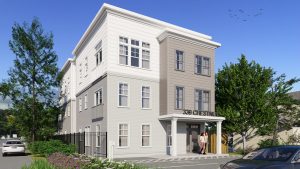Aired December 1, 2022. A look at the findings and suggested strategies to improve access to housing in Needham.
reported by Yuxiao Yuan
On November 16th, the Needham Housing Plan Working Group shared the findings of their housing study with the public. The draft plan identified unmet housing needs in town and provided recommended actions that can be taken in their near future. Many home buyers in Needham are willing to pay a high cost for the town’s desirable location and excellent schools, but houses seem to be becoming exponentially more expensive. If you look up homes on Zillow, properties close to one and a half million dollars dominate the map. On top of that there are more than just a few larger homes priced at two to four million dollars. The sales data from September 2022 corroborates this impression, which shows the median sales price has climbed to $1,450,000 for single family homes and $850,000 for condos. Needham’s prosperity is growing. A 53% increase in gross median household income has occurred since 2010, hitting $175,000 in 2021–more than twice the rate of inflation, and much higher than the national average. Yet this increase is still not able to catch up with the escalating housing prices. A household would have to earn about $280,000 to $328,000 a year to afford the median price of single-family homes in 2021. Even the median price of condo units in 2021 required an estimated income of $197,0000 to $230,000. These prices have also made rents more expensive, and have made home ownership less attainable for local employees, young families looking for starter homes, and senior residents looking to downsize. So what does the draft housing plan suggest to mitigate the issue? A lot of the recommendations pertain to changes in zoning laws, which determine what types of houses are allowed where. The goal is to open up opportunities for future development that can provide more diverse housing options. For example, the plan recommends that the town comply with the state’s MBTA Community Guidelines, which encourage housing production by requiring compliant communities to create zoning districts near MBTA stations where a certain level of multi-family units are allowed by right. The working group suggests adopting the dimensional regulations that apply to the existing “Apartment 1 Zoning District” in more areas along the Highland Avenue and Chestnut Street Corridor.An example of the Apartment 1 Zone is the area where Rosemary Ridge is located. “That is what’s giving us our basis,”co-chair Jeanne McKnight said at the November 16th hearing.”We’re taking that zoning, and saying ‘Well, why don’t we zone here for that, and here for that, and here for that.’ And in our business zones and industrial zones along this strip, we’ll allow multi-family by-right at the exact same density.” The plan also recommends adopting town-wide inclusionary zoning, which would require projects with six or more units to make at least 12.5% of those units affordable for households earning at or below 80 percent of the area’s median income. Another suggestion is to allow homeowners to rent out accessory dwelling units. The plan stated that this change could provide affordable studio and one bedroom rentals for seniors, young adults and local employees. It could also allow homeowners to stay in their homes by providing rental income to assist with housing costs. The working group also reviewed options that could control the level of tear-down activity across town. Where contractors replace modest older homes with larger expensive ones. As a result, Needham is losing smaller, single-family houses that used to serve the needs of first-time homebuyers. The town adopted dimensional restrictions once in 2017 to reduce the teardown rate. Now they are looking into more adjustments. “These considerations could include looking at dimensional thresholds for lot coverage, FAR [floor/area ratio] setbacks, height restrictions, tree removals–a whole variety of things.” said group member Emily Cooper at the meeting. “We’re not saying what the answer is right now, but we think it is something that should be looked at and explored. However, we want to balance that…with an understanding that there are homeowners who are concerned about their resale value, and they want to maximize their sale price. So, if we put too many caveats in place for the developer, then it affects the homeowner’s ability to to resell. So, it’s a delicate balance.” Other recommendations include considering allowing two family homes by-right in single-family zones and renovating the town-owned Stephen Palmer Building after the lease expires in 2027 for affordable and moderate income-rate housing. The draft plan is available on the town website and you can watch the full meeting on this website.










More Stories
ZBA Deliberates Tight Fit on Chestnut Street
Envision Needham Finds Resistance
Needham Open Studios Turns 25